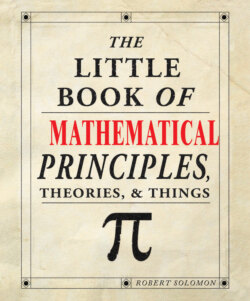Читать книгу The Little Book of Mathematical Principles, Theories & Things - Robert Solomon - Страница 22
На сайте Литреса книга снята с продажи.
5th century BC Greece Zeno’s Paradoxes Zeno (c. 490–c. 430 BC)
ОглавлениеThese paradoxes concern the infinite divisibility of space and time, and suggest that motion is impossible.
_______________
Matter cannot be divided indefinitely. There are particles that cannot be cut up any further. Is the same true of space and time, or can they be divided indefinitely? Zeno’s paradoxes concern this question.
Zeno’s paradoxes include the following two puzzles:
1. For the Dichotomy, suppose that you want to cross a field. Before you reach the other side you must get half way across. Before you reach the halfway point you must get a quarter of the way across and so on. To cross the field you must travel an infinite number of smaller distances, and so it is impossible to get across at all.
2. Achilles and the Tortoise have a race. Achilles can run ten times as fast so the Tortoise is given a lead of 100 paces. By the time Achilles has run 100 paces the Tortoise is 10 paces ahead. By the time that Achilles has made up these 10 paces the Tortoise is one pace ahead, and so on. Achilles can never catch up with the Tortoise.
Both these paradoxes cut space up into infinitely many pieces. In mathematics it is possible for infinitely many numbers to have a finite sum. This was shown by Archimedes in about 210 BC and formed an important part of mathematics in the 17th century. The two paradoxes can be written thus:
The Dichotomy:
1/2 + 1/4 + 1/8 + 1/16 + … = 1
Is it possible to cross the field?
Achilles and the Tortoise:
100 + 10 + 1 + 1/10 + 1/100 + … = 1111/9
Therefore, Achilles will catch up with the Tortoise after running 1111/9 paces – a finite distance.
Although this explanation satisfies mathematicians, it does not answer the question of how it is possible to accomplish infinitely many tasks in a finite period of time. Zeno thought it impossible and hence that any sort of motion is an illusion.
